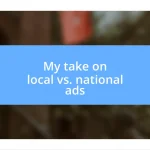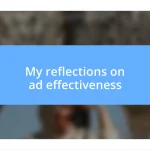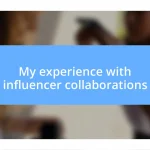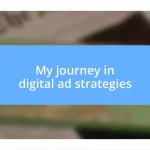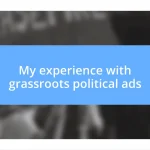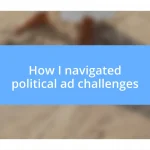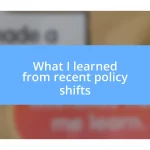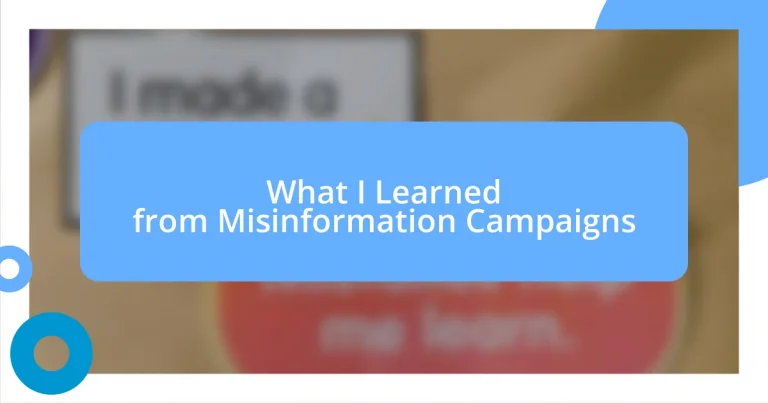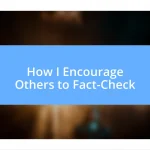Key takeaways:
- Misinformation campaigns exploit emotions like fear and outrage, leading to misperceptions and altered behaviors within communities.
- Developing critical thinking and media literacy skills is essential for individuals to evaluate information critically and foster informed discussions.
- Community engagement and education initiatives can combat misinformation effectively by promoting fact-checking and open dialogue.
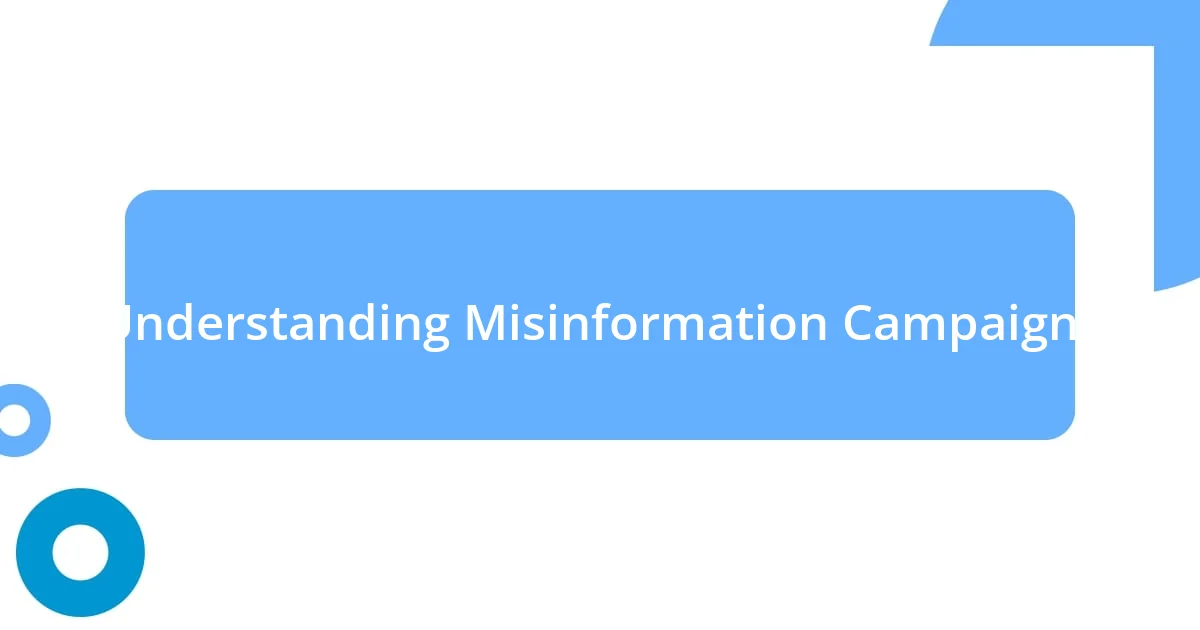
Understanding Misinformation Campaigns
Misinformation campaigns are orchestrated efforts to spread false or misleading information, often during critical moments in politics or public health. I remember a time when a friend shared an article about a health scare that turned out to be completely unfounded. It made me realize how easily we can fall into the trap of believing what we see online—especially when the information is presented with compelling visuals or catchy headlines. Have you ever stopped and questioned the authenticity of an article shared on social media? It’s an important practice that I’ve adopted since.
These campaigns take advantage of our emotions, leveraging fear or outrage to manipulate public perception. I once felt a wave of anger reading about a conspiracy theory that was trending; it felt visceral. Later, I discovered the claims were based on cherry-picked facts and outright fabrications. This taught me that emotions can cloud our judgment. How often do we react based solely on how something makes us feel rather than on a careful evaluation of the evidence?
When I look back at how misinformation affected my understanding of certain events, I’m struck by the ripple effects it causes. It not only misleads individuals but can also sway entire communities and, ultimately, shape societal norms. Have you considered how misinformation might alter your perspective or decisions, sometimes unwittingly? By exploring the origins and intentions behind these campaigns, we can better protect ourselves from their influence.
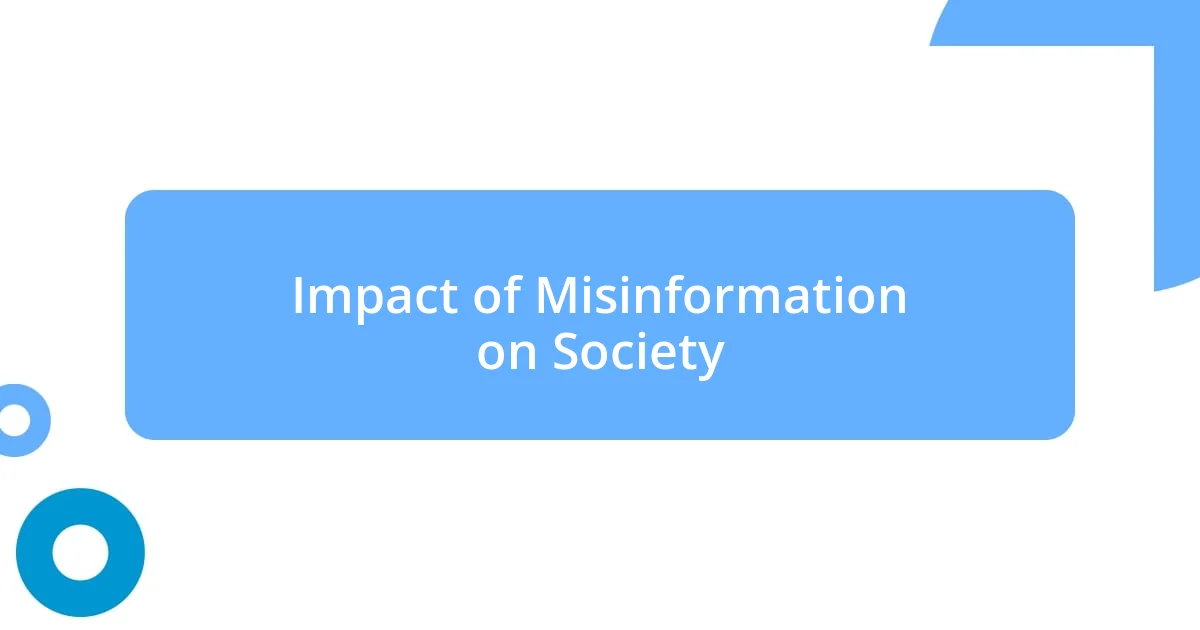
Impact of Misinformation on Society
The impact of misinformation on society is far-reaching and often unsettling. I remember scrolling through social media and coming across a viral post that claimed a local health initiative was harmful. The reaction in the comments was intense, with people expressing fear and distrust without bothering to fact-check. This experience highlighted for me how quickly misinformation can create panic, sowing divisions in communities where trust should be paramount.
Moreover, misinformation doesn’t only skew public opinions; it can alter behaviors. A friend of mine stopped vaccinating her children based on a viral conspiracy theory, believing it would keep them safer. Unfortunately, her decision was rooted in fear fueled by disinformation, which not only affected her family but also threatened community immunity. I started realizing that each shared post carries weight, capable of influencing lives in ways we might not immediately see.
In another instance, I witnessed firsthand how misinformation twisted perceptions during an election cycle. Friends became polarized over articles that dramatically misrepresented the candidates’ positions. It felt surreal watching friendships fray over baseless claims, making it clear that misinformation is a barrier to constructive dialogue. Honestly, it brought me to question how we communicate with each other in today’s information-heavy environment.
| Type of Impact | Description |
|---|---|
| Emotional Manipulation | Utilizes fear or anger to sway public perception. |
| Behavioral Change | Can alter actions, like vaccine hesitancy, based on false information. |
| Social Division | Creates rifts in communities, leading to polarized opinions and strained relationships. |
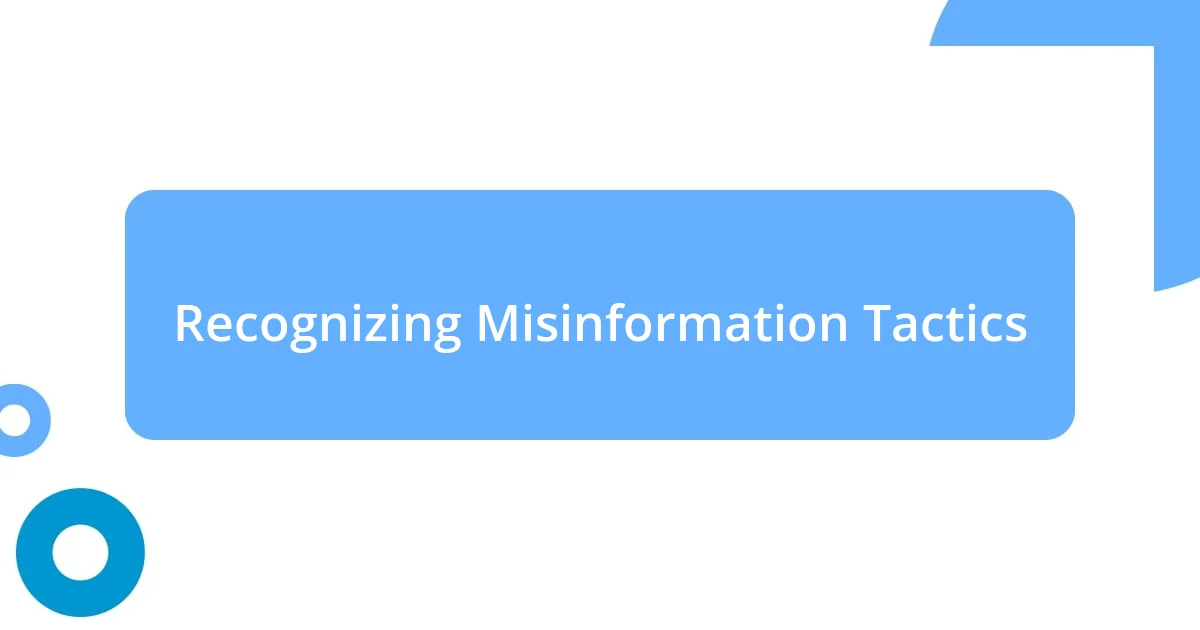
Recognizing Misinformation Tactics
Recognizing the subtle ways misinformation can infiltrate our thinking is crucial. The tactics often harness emotional triggers to heighten engagement. I recall a time when a friend forwarded me an alarming infographic regarding a well-known public figure. The dramatic visuals and urgent language drew me in, yet I felt an uneasy tug in my gut, prompting me to investigate further. That moment taught me that the more sensational an item appears, the more cautious I should be.
Here are some tactics often used in misinformation campaigns:
- Emotional Appeals: Content is designed to evoke strong feelings like fear or outrage, making it hard to think critically.
- Clever Visuals: Eye-catching images or memes catch attention but may distort the true message.
- Selective Reporting: Facts can be cherry-picked to support a specific narrative while ignoring contrary evidence.
By being aware of these tactics, I find myself better equipped to navigate an increasingly confusing information landscape.
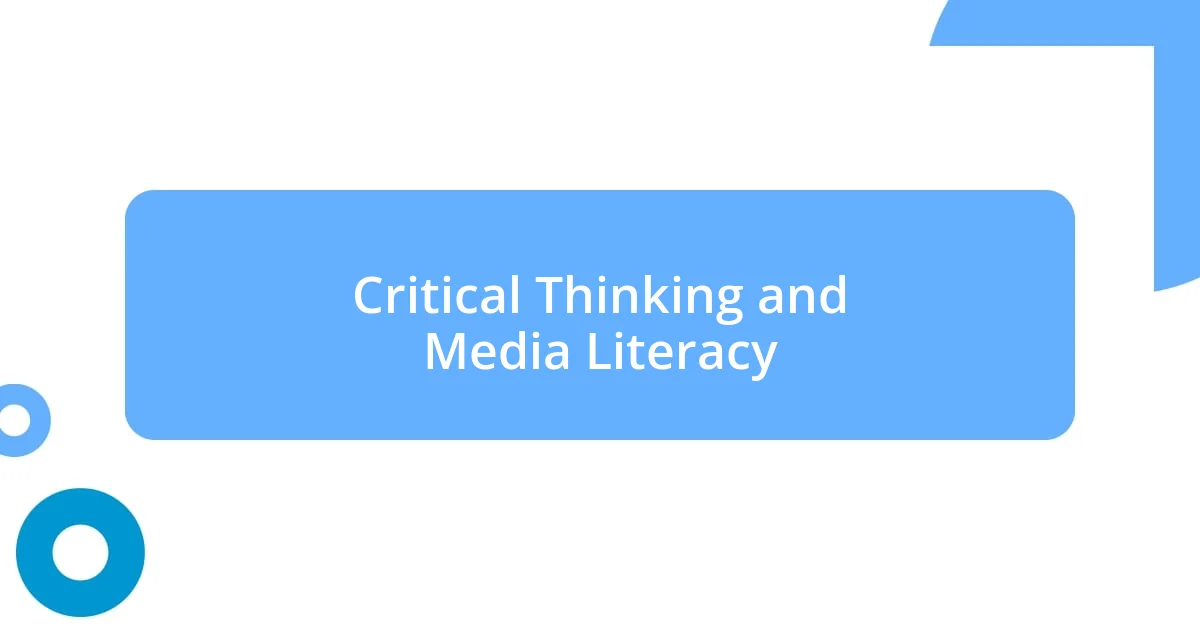
Critical Thinking and Media Literacy
Critical thinking and media literacy are essential skills in today’s fast-paced information landscape. I remember attending a workshop on media literacy where the instructor challenged us to evaluate news stories against multiple sources. That experience stuck with me; it reinforced the idea that not all news is created equal. How often do we simply accept what we see online without second-guessing it? Developing that critical mindset has become a vital part of how I engage with information.
Sometimes, I find myself pausing before sharing an article or social media post. There’s this pit in my stomach that reminds me to ask: “Is this credible?” This moment of reflection can be the difference between spreading awareness and contributing to the cycle of misinformation. It’s empowering to sift through facts and narratives instead of letting them wash over me. I’ve learned that questioning the validity behind headlines not only strengthens my understanding but also fosters informed discussions with those around me.
Ultimately, honing my media literacy skills has taught me to approach information with a healthy dose of skepticism. I recall reading a trending article that turned out to be based on unverified claims. The fallout among friends was palpable, with divisions popping up over sensationalized news. It left me pondering how easily our perceptions can be manipulated, and it reinforced my commitment to think critically and evaluate the media I consume. How can we expect healthy dialogues if we don’t scrutinize the information that fuels them?
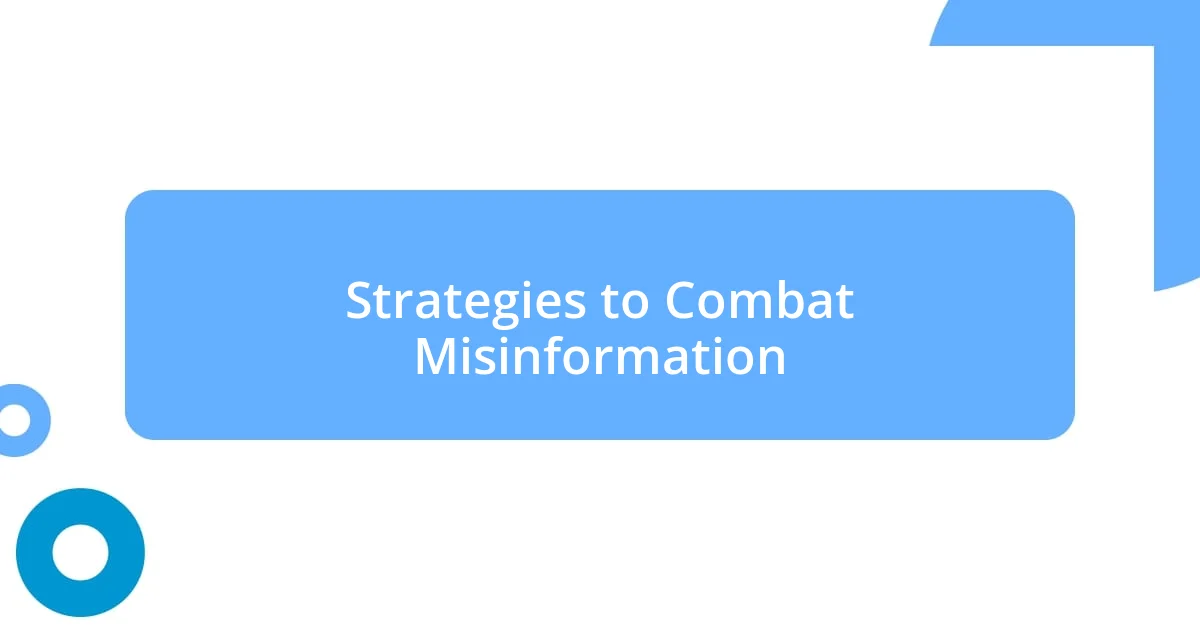
Strategies to Combat Misinformation
When I think about the role of education in combating misinformation, it’s hard not to feel hopeful. Engaging in community discussions or workshops where the focus is on the importance of fact-checking can create a ripple effect. I recall attending a local seminar where the facilitator challenged us to fact-check viral social media posts in real time. Watching everyone’s expressions shift from disbelief to enlightenment was a powerful reminder of how education can empower us to be both discerning and proactive.
Another effective strategy lies in collaboration with technology. Platforms can introduce features that encourage users to question the content they encounter. I once encountered a browser extension that flagged dubious sources as I browsed. It felt like having a trusted friend nudging me, prompting me to pause and reflect on the information’s validity before I clicked “share.” Isn’t it fascinating how technology can become our ally in this battle against deceptive narratives?
Moreover, fostering a culture of open dialogue is crucial. I often find myself in conversations where we dissect recent news stories together. This collaborative approach not only bolsters our understanding but also cultivates a sense of community. I can’t tell you how uplifting it feels to hear someone say, “Let’s think this through,” rather than jumping to conclusions. These moments underscore how collective inquiry can effectively challenge the echo chambers that misinformation often thrives in. Why not create spaces where critical conversation is the norm rather than the exception?
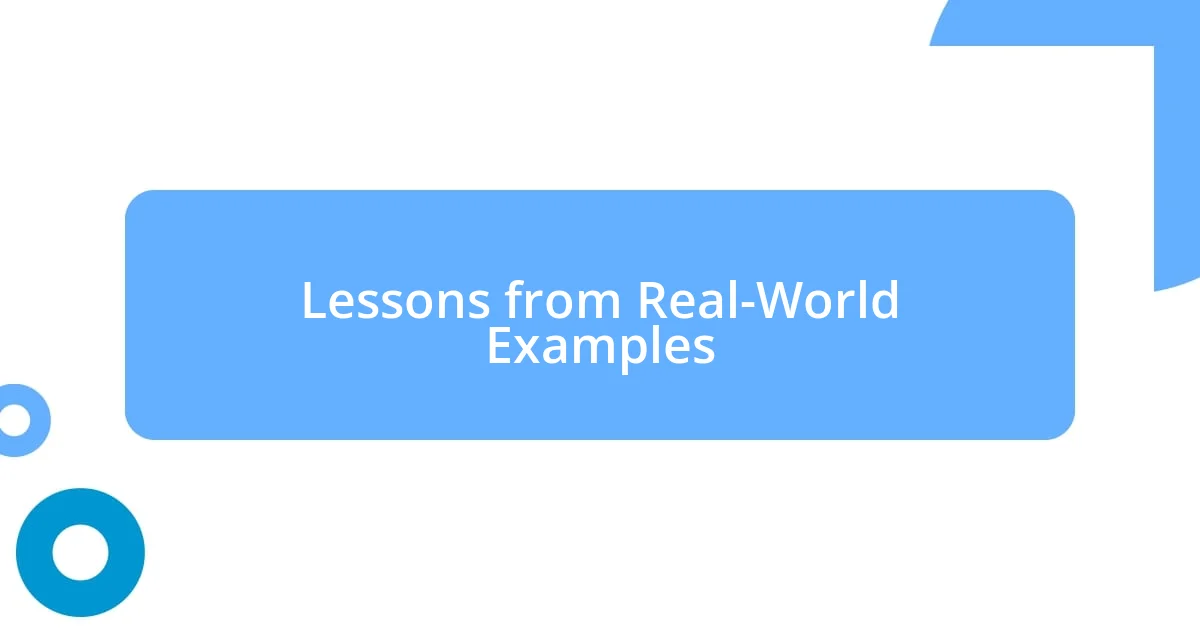
Lessons from Real-World Examples
Reflecting on real-world examples of misinformation campaigns, I can’t help but think about the infamous pizza-related conspiracy that emerged during a politically charged period. I had friends sharing posts claiming that a particular restaurant was involved in nefarious activities. The reactions were visceral—anger bubbled up, and I watched friendships strain under the weight of those falsehoods. It made me realize just how quickly misinformation can distort our perceptions and lead to irrational decisions. Doesn’t it strike you as alarming how easily we can become pawns in someone else’s agenda?
Another powerful lesson came from the COVID-19 pandemic, where a plethora of misinformation circulated about the virus and vaccines. I remember scrolling through social media, feeling overwhelmed by conflicting information. I decided to attend an online panel discussion featuring health experts. Listening to their perspectives not only eased my own fears but also equipped me with the tools to address misinformation confidently. How can we navigate crises if we don’t seek out credible voices in the chaos? Engaging with experts directly can bridge the gap between fear and understanding—a lesson we can all benefit from.
Then there’s the observation of how influential public figures share information. I recall a viral tweet from a celebrity which turned out to be misleading. The immediate backlash highlighted a crucial point: with great influence comes great responsibility. It left me pondering, why aren’t we holding these figures accountable for their words? I learned that our response as a community matters deeply; instead of spreading outrage, I saw some people choosing to educate others calmly. This approach, I think, fosters a more thoughtful conversation rather than a cycle of blame. Isn’t this the kind of dialogue we need in these turbulent times?
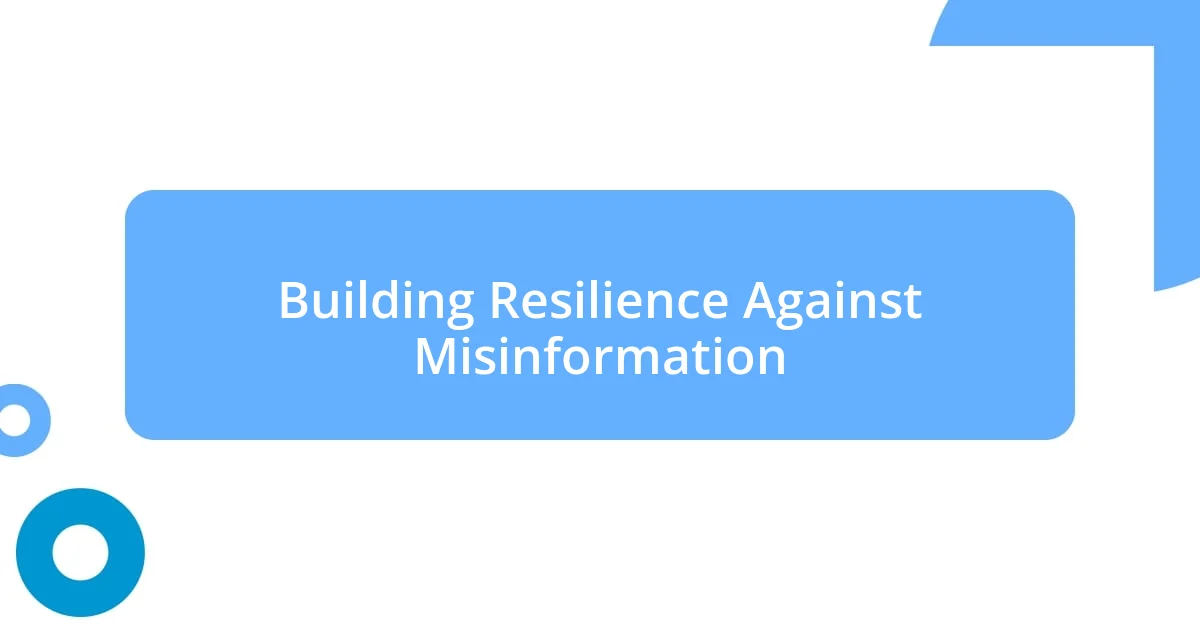
Building Resilience Against Misinformation
Building resilience against misinformation starts at the individual level. I remember a time when my own biases clouded my judgment after reading a sensational headline. It was a sobering moment when a friend pointed out the lack of evidence in the article I was sharing. This experience taught me the importance of taking a step back and examining my own reactions before joining the conversation. Why do we sometimes rush to judgment without verifying the facts?
Equipping ourselves with critical thinking skills is another essential layer of resilience. I often find that taking a moment to ask myself a few key questions helps me sift through information effectively. For instance, I’ve developed a habit of checking the source and looking for corroborating evidence from multiple outlets. This simple practice not only clarifies my understanding but also empowers me to engage in discussions with more confidence. Doesn’t it feel rewarding to navigate through the noise with clarity?
On a broader level, participating in community initiatives can further strengthen our collective ability to combat misinformation. I’m inspired by local groups that host information-sharing events where we decode news stories together. When I see people from diverse backgrounds come together to share insights, it fosters a sense of solidarity in the face of misleading narratives. How can we afford to overlook this unity? Engaging in such activities not only enhances our resilience but also reinforces the notion that we are all in this fight together.
